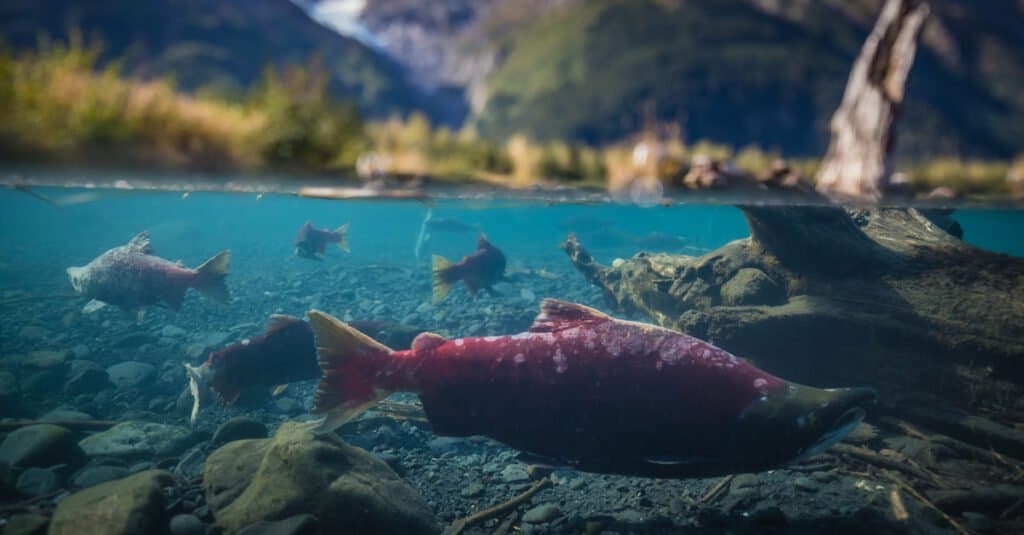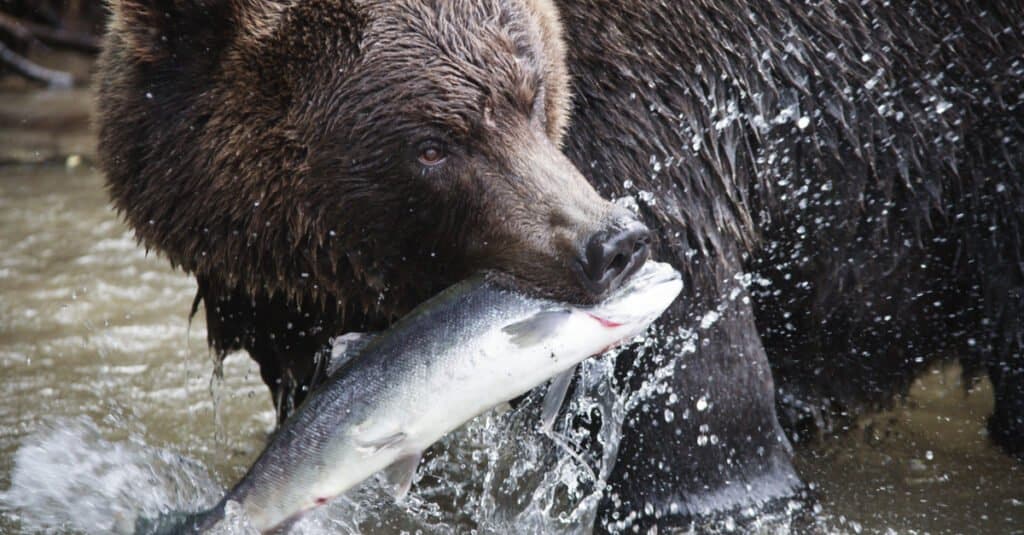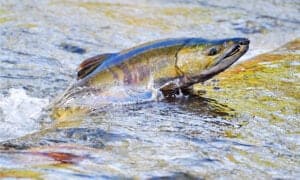Salmon are famous for their returning to their home streams to spawn, leaping out of the water along the way. Although they may seem like the least-interesting fish, salmon are actually unique because many species spend part of their lives in freshwater and another portion in the salty waters of the open ocean. They have to feed in each situation, so what do salmon eat?
Take a journey into the life of a very common, unassuming fish and learn how salmon survive in difficult circumstances along with the role that humans play in their lives.

What Foods Do Salmon Eat?
Salmon eat insects, amphibians, and fish. They are strictly carnivorous creatures that feed on others no matter if they are living in freshwater or saltwater. However, the salmon’s diet varies significantly depending on where it’s living and the age it has achieved.
Since they are opportunistic hunters, the foods that salmon commonly eat include:
- Shrimp
- Mayflies
- Stoneflies
- Sand eels
- Grasshoppers
- Sprats
- Zooplankton
- Herring
- Crayfish
- Caddisfly larvae
- Krill
- Squid.
These foods include both ones that salmon eat in freshwater as well as in the ocean.
Generally speaking, salmon spend the first portion of their lives in freshwaters where they grow up in streams and rivers. Salmon return to these places to spawn years later when they reach maturity. In the interim, salmon move into the ocean if they are not one of the landlocked species.
While in freshwater, salmon mostly eat the insects that were listed such as mayflies and caddisfly larva. As adults, they are larger and more capable hunters, and different foods become available to them in the ocean. They feed on other fish, crustaceans, and even mollusks.
The primary saltwater food pursued by salmon is shrimp; some 95% of their prey are shrimp in pure numbers. However, that only accounts for 30% of their food weight whereas fish, especially lanternfish and pearlsides, comprises 66% of their weight.
Salmon are highly capable hunters, catching their prey at the surface as well as in the ocean depths. Their incredible sense of smell helps them track potential prey and is used to help guide them back to the original stream from which they spawned at the end of their lifecycle.
Once they track down their prey, a salmon’s quick attacks and bites help them catch their prey off guard and secure their food.
What Do Salmon Eat in Captivity?

While in freshwater, salmon mostly eat insects like mayflies and fly larvae.
©907Shots/Shutterstock.com
Salmon are one of the most commonly farmed and caught fish in the world. The process of farming and harvesting salmon is called aquaculture, and it has increased more than tenfold in the past four decades, surpassing naturally caught fish by a margin of 2.3 million tons.
Salmon farms are made up of hatcheries and sea cages, the latter being pens made of mesh that measure over 100 feet across and 30 feet deep. These farms are set up in natural water systems to provide salmon with an easily managed living situation. Still, the captive salmon are fed by the farm operators in addition to eating naturally occurring foods like zooplankton.
In salmon farming operations, the most common food served to the growing fish is dry pellets colloquially called “salmon pellets.” They contain a variety of ingredients based on which company supplied them, but common ingredients include:
- Plant and vegetable material
- Grains
- Fishmeal
- Vitamins
- Minerals
- Amino acids.
These pellets are fed to salmon at regular intervals to bolster their growth and get them ready to be harvested. Once they have reached the right size, they are usually transported in wet-well ships directly to the processing plant, cutting down on processing time and ensuring the meat remains fresh.
How Much Do Salmon Eat?
Salmon are believed to need about 50 grams of food each day if they are 60 centimeters long or more. That is not a great deal of food, especially when considering that salmon regularly weigh more than 10 pounds.
Farmed salmon need less food because they spend less energy seeking out their next meal. Unlike salmon swimming in the ocean that need to find and eat another creature, their meals are regularly scheduled. The amount of feed pellets that salmon eat in captivity varies, but they usually grow about a pound for every 1.2 pounds of feed they consume.
Salmon that return to their spawning grounds stop eating once they hit freshwater. That means they need a significant amount of stored energy before their journey back to where they were spawned, a time called the salmon run.
During the salmon run, the fish makes its way back to where it started life, rarely eating, if at all. Once the fish successfully reproduce, the vast majority of them begin to deteriorate and die. They put all their energy into that final act, ensuring the future for the next generation. A few survive, and some even make the journey back out to sea.
What Predators Hunt Salmon?

Salmon are often consumed by bears and other predators in freshwater.
©DPS/Shutterstock.com
Salmon, not having much in the way of protective measures, often fall prey to other creatures. Their agile swimming and infrared sight can steer them out of harm’s way in some cases, but not always. Chiefly among their predators are humans, who catch salmon in freshwater and saltwater or farm them for food. In this way, millions of salmon are harvested and killed every year.
Humans are not the only cause of death for salmon. Consider this list of salmon predators:
These are all common salmon predators, capturing them in freshwater, saltwater, often at inopportune times such as when they’re leaping out of the water to travel or clean their scales.
Salmon are rather unique fish. They’re one of the most successfully farmed fish in the world, and their ability to return to their original spawning grounds is wondrous to behold.
Since they live in such different areas throughout their lives, salmon encounter a lot of foods. Salmon eat a variety of creatures throughout their lives, including insects, other fish, shrimp, and even the odd mollusk. Yet, a great deal of salmon subsist on the salmon pellets and remain in fish farms for their entire lives.
Summary of What Salmon Eat
Here’s a recap of what foods salmon commonly consume:
| Number | Food |
|---|---|
| 1 | Shrimp |
| 2 | Mayflies |
| 3 | Stoneflies |
| 4 | Sand eels |
| 5 | Grasshoppers |
| 6 | Sprats |
| 7 | Zooplankton |
| 8 | Herring |
| 9 | Crayfish |
| 10 | Caddisfly larvae |
| 11 | Krill |
| 12 | Squid |
The photo featured at the top of this post is © Kevin Cass/Shutterstock.com
Thank you for reading! Have some feedback for us? Contact the AZ Animals editorial team.






